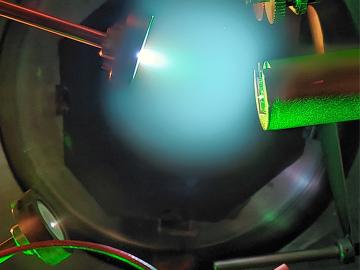
Filter News
Area of Research
News Type
News Topics
- (-) Artificial Intelligence (12)
- (-) Computer Science (26)
- (-) Energy Storage (10)
- (-) Microscopy (7)
- (-) Quantum Science (5)
- (-) Security (5)
- (-) Transportation (16)
- 3-D Printing/Advanced Manufacturing (16)
- Advanced Reactors (7)
- Big Data (14)
- Bioenergy (5)
- Biology (8)
- Biomedical (6)
- Biotechnology (2)
- Buildings (7)
- Chemical Sciences (7)
- Clean Water (9)
- Composites (5)
- Critical Materials (3)
- Cybersecurity (2)
- Emergency (1)
- Environment (24)
- Exascale Computing (1)
- Fossil Energy (1)
- Frontier (1)
- Fusion (7)
- Grid (7)
- High-Performance Computing (5)
- Isotopes (5)
- ITER (1)
- Machine Learning (12)
- Materials (5)
- Materials Science (24)
- Mathematics (4)
- Mercury (2)
- Molten Salt (4)
- Nanotechnology (9)
- National Security (4)
- Neutron Science (15)
- Nuclear Energy (21)
- Partnerships (1)
- Physics (8)
- Polymers (7)
- Simulation (6)
- Space Exploration (4)
- Summit (3)
Media Contacts

Researchers at Stanford University, the European Center for Medium-Range Weather Forecasts, or ECMWF, and ORNL used the lab’s Summit supercomputer to better understand atmospheric gravity waves, which influence significant weather patterns that are difficult to forecast.

Chad Parish, a senior researcher at ORNL, studies materials at the atomic level to improve nuclear reactors. His work focuses on fusion and fission energy, using microscopy and collaborating with experts to advance materials for extreme environments.

From during his early years at NASA to his current role a researcher and group leader, Peter Fuhr has pushed the boundaries of optical and sensor technology. Fuhr’s path is marked by wacky creativity that can’t confine itself to challenges in a single field. No idea is too far out to try out — and so many of them work that Fuhr has a host of inventions and start-ups under his belt.

The ForWarn visualization tool was co-developed by ORNL with the U.S. Forest Service. The tool captures and analyzes satellite imagery to track impacts such as storms, wildfire and pests on forests across the nation.

Scientists at ORNL are studying the failure mechanisms of a new solid electrolyte battery to enhance long-term storage for renewable energy, aiming to make wind and solar power more reliable for the electric grid.

Huan Zhao, a Eugene P. Wiger Fellow at ORNL, focuses on advancing quantum materials and information technologies, inspired by his grandfather's passion for education. His research in energy-efficient memory devices and sensitive quantum light sources reflects his commitment to scientific progress and education equity.

The Advanced Plant Phenotyping Laboratory at ORNL utilizes robotics, multi-modal imaging, and AI to enhance understanding of plant genetics and interactions with microbes. It aims to connect genes to traits for advancements in bioenergy, agriculture, and climate resilience. Senior scientist Larry York highlights the lab's capabilities and the insights from a new digital underground imaging system to improve biomass feedstocks for bioenergy and carbon storage.

In a game-changing study, ORNL scientists developed a deep learning model — a type of artificial intelligence that mimics human brain function — to analyze high-speed videos of plasma plumes during a process called pulsed laser deposition.

ORNL has partnered with Western Michigan University to advance intelligent road infrastructure through the development of new chip-enabled raised pavement markers. These innovative markers transmit lane-keeping information to passing vehicles, enhancing safety and enabling smarter driving in all weather conditions.

As a mechanical engineer in building envelope materials research at ORNL, Bryan Maldonado sees opportunities to apply his scientific expertise virtually everywhere he goes, from coast to coast. As an expert in understanding how complex systems operate, he’s using machine learning methods to control the process and ultimately optimize performance.


